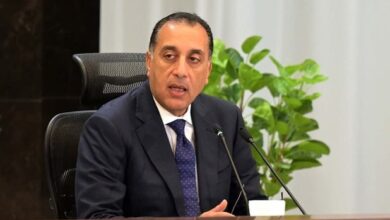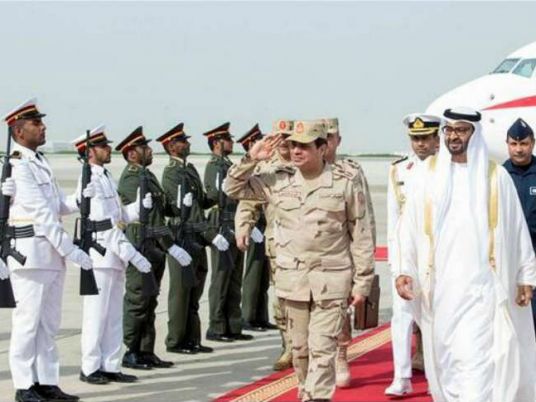
Tuesday marked one year since Egypt concluded a massive economic conference in the resort city of Sharm el-Sheikh, a major event on which the government of President Abdel Fattah al-Sisi pinned hopes for luring world investors to the country’s limping economy.
However, there is some debate about how many deals announced at the Egypt Economic Development Conference have come to fruition and how many have floundered. Meanwhile, much of the money promised for investments has failed to materialize, while economists are concerned about the growing national debt.
At best, it is a picture of mixed success, although government officials are keen to point out the many projects for which physical signs of activity are evident, along with the deals at the planning stage that seem sure to be realized soon.
Agreements signed below half of touted value
The total value of memos and agreements signed by the government during the conference has been estimated at US$130 billion. That figure is based on scattered statements by government officials. The enormous amount quoted caused many citizens to feel hopeful of major improvements in the country, and the accomplishment became the topic of the hour in the media and even among the general public.
However, according to Investment Minister Ashraf Salman, whose ministry oversaw progress in the signing of projects during the conference, only $58 billion out of the trumpeted $130 billion has actually materialized.
Speaking to Al-Masry Al-Youm, Salman said the actual amount was the outcome of signing 19 agreements covering the petroleum, electricity and transportation sectors. He added that out of those, four agreements on petroleum and four on electricity have been implemented, with a total cost of LE9.46 billion.
“The total of MOUs signed stood at nearly 41, eight of which were transformed into contracts and agreements in the fields of housing, planning, investments and tourism,” Salman revealed.
On the other hand, eight MoUs were cancelled pertaining to housing, transport, tourism and investment, said the minister.
Loans and grants drawn via the conference totaled $12,706, of which 12 worth $9,57 billion have been finished in terms of legal procedures, with the remaining ones underway.
Achievements in each sector
Detailing progress in agreements by sector, Salman said that an electricity deal worth $1.3 billion was revoked. “We have signed contracts worth $35 billion for electricity production, and it will be six months before they come into force. That will add 25,000 megawatts,” Salman explained.
The transportation sector has begun implementing one of four agreements worth $415 million. In the housing field, four out of eight memos were turned into contracts. “The housing sector has seen agreements worth LE170 billion to be implemented over seven years,” said the minister. In the planning sector, two MoUs worth $6 million turned into contracts; that’s out of a total of three memos.
“The rate of implementation in the petroleum sector has reached 100 percent,” according to Salman. “That leaves nearly $27.8 billion in agreements pending.”
PPP stands still
Though the Finance Ministry announced during the conference it was planning to engage in dozens of Public-Private Partnership projects, none of them has been finished so far. According to Ater Hannoura, director of the ministry’s PPP Central Unit, these include sea and land ports, four mega-stadiums, multi-storey car parks, recycling centers, a call-center city, a notary offices mechanization scheme and updates to the Nile River buses service.
While feasibility studies for four projects have concluded, with investments estimated between $25-30 billion, none of those had been offered for international bidders since the conference wrapped up.
Housing contracts
The greatest progress has been seen in Housing Ministry projects. Minister Mostafa Madbouly said six memorandums of understanding were turned into contracts during the conference. The investors have taken charge of the land on which the projects are to be built and the designs have been started. Investment for these projects totals over LE100 billion, the minister said, adding that the ministry signed contracts for projects in the new administrative capital with a Chinese company considered one of the biggest contractors in the world.
Electricity projects
The Electricity Ministry is concluding final studies for various projects that were agreed on during the summit, with Ministry Spokesperson Mohamed al-Yamany saying most of the projects have progressed well since then. Most important is the construction of three power plants in co-operation with Siemens, with a total capacity of 14,400 megawatts.
In remarks to Al-Masry Al-Youm, Yamany said that some of the planned power generating involve combined-cycle power stations, while others depend on coal and others on renewable energy. There is also an agreement on establishing a pumping and storage station and another to introduce "smart meters" to manage the electricity grid.
Aero City announced
A key transportation and logistics project discussed at the summit was the Aero City development, to be built next to the Cairo International Airport. Civil Aviation Minister Hossam Kamal announced the project's approval in front of several Egyptian, Arab and international investment banks and investors.
The ministry promoted two investment zones with a total area of 3 million square meters, including several logistic, tourist, trade and entertainment elements aimed at boosting the national economy.
Aero City, which is due to be completed in 2020 and has a total investment of LE80 billion, is expected to provide jobs for thousands of people. According to studies, by 2040, the facility will make profits estimated at LE422 billion.
Egypt will become the 19th nation to build commercial and residential areas specifically linked to airports, a practice that has proved successful in Singapore, Dubai, Malaysia, US, England, South Africa, Germany, China and others, Kamal said.
$4.2 bn borrowed, national debt climbing
Despite official claims of success in signing deals and progress on projects since then, there has been concern about the growing amount of foreign debt that Egypt has accumulated.
Since last year's summit, the government has borrowed about $4.2 billion from international institutions, amid official statements that Egypt's foreign debt has reached unprecedented levels, estimated at $46.1 billion by the end of December.
The total domestic debt reached LE2.259 trillion ($288 billion), compared to about LE2.116 trillion by the end of June of last year.
The government resorted to borrowing from international institutions, despite announcing plans to attract local and foreign investments, ranging between $10 billion and $12 billion, according to former statements by Ashraf Salman, the Minister of Investment.
Gulf countries, including the UAE, Saudi Arabia, and Kuwait also announced aid packages for Egypt worth $12.5, including $6 billion as deposits at the CBE to back the foreign-currency reserves.
After the conference, Salman announced that contracts and project agreements worth $130 billion had been signed.
Draft contracts worth about $30 billion, as well as memorandums of understanding equal to more than $100 billion, were signed during the conference, said Rashad Abdou, a professor of economics at the Faculty of Economics and Political Science, Cairo University.
Abdou accused the Cabinet of negligence and failing to follow up the implementation of projects, adding that the Cabinet was moving in the opposite direction of the president's aspirations.
"If the contracts and memoranda of understanding signed during the Conference were implemented, we would have attracted investments of more than $100 billion, decreasing the risk of borrowing from abroad," Abdou said.
He stressed that Egypt is suffering from a pressing problem in the provision of the dollar as a result of an imbalance in supply and demand on the dollar.
According to Abdou, borrowing from abroad showed trust in Egypt's economy and its ability to repay loans to international institutions.
The World Bank provided the largest proportion of loans to the Egyptian government, equal to $2.450 billion, followed by the Chinese Central Bank, which provided $1 billion in January 2016 to back foreign reserves.
The rest of the loans are divided between the African Development Bank and the Saudi Fund for Development.
The purposes of the loans ranged between support for the state budget, funding government projects and social projects that supported poor families.




